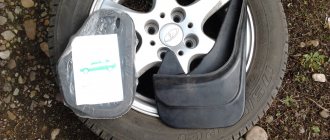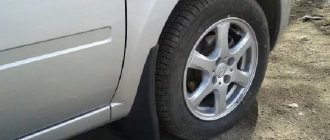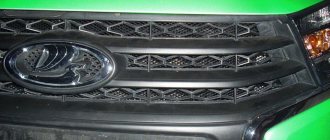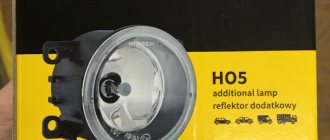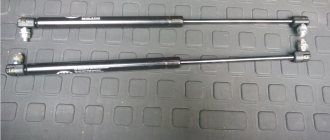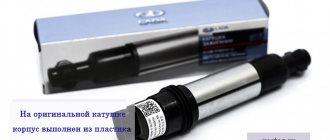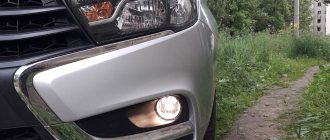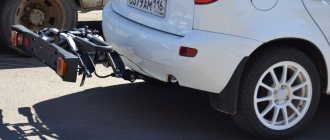AvtoVAZ management decided not to equip the Lada Vesta, which is currently the company’s flagship model, with rear mudguards. This practice is widespread throughout the world and there is nothing unusual about it. Therefore, mud flaps, like many other accessories for the Lada Vesta, will have to be purchased independently. But before shelling out money for this additional element, you should understand how necessary it is for a Russian car. In addition, you need to be careful when choosing mudguards, as they come in different qualities. This article will also provide instructions for installing these products.
The correct choice of rear mud flaps for the Lada Vesta will not only improve the appearance of the car, but will also protect it from many adverse factors. The car body will be protected from splashes of water and dirt, so the car will be able to successfully resist corrosion for many years. But in order for mud flaps to effectively protect your car, they must be correctly selected and installed.
Types of mud flaps
Mud flaps (hereinafter referred to as protection) are made of impact-resistant rubber and plastic adapted to temperature changes.
The former are more resistant to damage and wear. The material from which they are made is elastic and does not break when bent, which is very convenient when overcoming road obstacles, uneven surfaces, and potholes.
Plastic accessories are purchased less often than rubber ones. It's not even a matter of price, but the systematic accumulation of dirt and moisture in the grooves of the sidewalls.
Among the advantages of plastic is “holding” its shape when moving at high speeds. At the same time, even a shallow pothole on the road will deform the plastic protection.
The final choice of mudguard remains with the owner of the technical equipment. If necessary, get advice from service station specialists regarding the compatibility of protection with your car model.
How important are mud flaps for a car?
When releasing the Lada Vesta sedan onto the automobile market, the manufacturer AvtoVAZ for a long time doubted the need to equip the car with rear mudguards. Therefore, car owners need to buy them separately from the car itself.
This feature is inherent not only to this model, but also to other modifications of passenger cars of the domestic automobile industry. The outer shell of the car is more exposed to sand, dirt, water and other chemicals that are sprinkled on city road surfaces. As a result of this, the rear part of the body is subject to constant negative environmental influences on the car body.
The listed factors contribute to the rapid appearance of corrosion of the bottom, as well as changes and damage to the paintwork of plastic surfaces (bumper, etc.). Also, when driving at high speed, body elements are exposed to air currents, which are another source of pollution.
It is for these reasons that mud flaps are considered to be one of the most important protective elements of the body.
Do-it-yourself rear mudguard installation on Lada Vesta
Necessary tools for work:
- wheel wrench;
- electric drill;
- Phillips screwdriver;
- metal brush;
- new protection kit.
How to install mudguards. Step-by-step replacement guide
- We place the car above the inspection channel.
- We squeeze the handbrake and turn off the ignition.
- Jack up the rear of the car and remove the wheel.
- We clean (rinse) the rear part of the wheel arch where the fender liner is attached.
- Unscrew the two lower screws that secure the fender liner to the car body.
- We apply protection and outline the location of future holes.
- We drill holes with a drill and lubricate them with grease to prevent the development of corrosion.
- We fix the mudguard with self-tapping screws, which are supplied with the accessory.
- We put the wheel on the studs and lower the car into the transport position.
- Do-it-yourself replacement of rear mudguards is completed.
Related link:
Tips for installing hood gas struts on your Lada Vesta yourself
Buying mudguards: prices and manufacturers
A sufficient period of time has passed since the start of sales of the West sedan and station wagon. Today there is already the possibility of a wide selection of accessories suitable for both types of Lada vesta body. Let's focus on the most worthy manufacturers. There is no point in considering Vesta's standard protective accessories. They do not please with the variety of design options and prices (VAZ produces them from polyurethane). Let's also forget about universal ones - they need to be additionally prepared before installation by “adjusting” the fasteners and sizes. Below is a table with the names of manufacturers. Below are approximate prices in Russian rubles for goods intended for the West (the cost of a pair is indicated, the price includes an installation kit with instructions):
- Novline - RUB 1,300.00;
- Seintex - RUB 1,200.00;
- LLocker—RUB 750.00;
- AvtoDriver - RUB 750.00;
- NorPlast - RUB 1,000.00;
- NLF - RUB 1,000.00;
- Guard - 800.00 rub.
Installing the latter eliminates the need for a drill - factory-prepared holes are sufficient.
The price of front and rear ones from the same manufacturer is almost the same. The most expensive ones are made of polyurethane; they have the properties of resisting external factors: wear is reduced by 3 times compared to rubber, and the strength of the material is 22.5 times.
For Lada Vesta vehicles, mudguards are suitable for installation on all existing body types of the model range of new AvtoVAZ products. We consider it necessary to provide the article number of the standard front mudguards - 99999218111382. The article number of the mudguards installed on the rear wheels differs insignificantly - 99999218001382. By entering the specified order of numbers into the search, the computer user will find offers to buy original products from VAZ and duplicates produced by third-party companies.
The Vesta crossover and station wagon, fortunately or unfortunately, are not endowed with a special shape and catalog number for both types of mudguards. Therefore, owners of a regular SW station wagon and an “elevated” one in the interests of successfully fighting the treachery of Russian roads, a “brother” with the ending “Cross” in the name, will not have any problems finding and having the part. You will find the catalog number of the accessory in the previous subparagraph, going up a few lines.
The article numbers for sedans are no different from the article numbers for station wagons.
Review of Manufacturer Prices
| Serial number/catalogue number | Price in rubles |
| AvtoVAZ Rear 99999218001382 | From 1100 |
| Novline 89108-0-147-2689 | From 1100 - 1200 |
| 89109-73-147-2689 | From 1100 - 1200 |
| Guard VS-ZBLV | From 900 |
| Avtodriver AVTMODEL2 | From 900 |
| AVTMODEL1 | From 900 |
| NLF 52.33.E10 | From 900 |
| *prices are as of May 2019 | |
Installation
When you choose mud flaps in a store or on the market, remember that the average estimated cost for one set is at least 1300 - 1500 rubles.
More expensive, there is also no point in buying.
Before you begin installing this part, you will need to carry out some preparatory procedures. The first thing you need to do is remove both rear wheels from the Lada Vesta. Next, using a special brush, clean the surface of the arch from all dirt and let it dry completely.
Now that the surface of the arch is cleaned and prepared for installation, it is necessary to mark the places on it where the screws that secure the mud flaps to the body will go. To fasten this part, it is recommended to use screws measuring 4.2 mm in diameter and no more than 15 mm in length.
After the holes are made in the body, treat them with anticorrosive. Next, install the rear mudguards in their places, on the same side as the front ones. Now you can safely fasten them and check how tightly they fit.
This completes the work of installing mudguards on the Lada Vesta car. It is worth noting that it is not necessary to buy mud flaps specifically for this model. A cheaper and higher quality option may be products from Sparco and Elegant.
Conclusion
Installing rear mud flaps is necessary and important to protect the wheel arches of the car. Regarding the material of the accessory, this is a personal matter: rubber or plastic. The decision on the choice is made by the owner of the vehicle.
Workers at a number of certified workshops insist on purchasing rubber protection, which will extend the life of the mudguard to several years.
Reviews
| № | Positive |
| 1 | Andrey (Avtodrom): in the third year of operation of the car, I installed mudguards. The process is not at all complicated, but it does not forgive mistakes. |
| 2 | Sergey (Avtotema): I’m pleased with the domestic plastic protection, although my comrades dissuaded me, saying they were impractical in the pits. |
| 3 | Kirill (Autoreview): I’ve been riding on domestic fenders for two seasons now, there are no comments on the quality. |
| 4 | Alexey (Avtoria): I ordered the installation of the fender liner at a service station, the guys completed it in half an hour. Provided a one year warranty on the accessory. |
| 5 | Alexander (Drom): I installed the wheel arch protection on my own, for the first time, I thought it wouldn’t work. Half an hour and the protection is installed. |
| 6 | Stanislav (Driving): the protection is good, practical, and does not deform in the cold. |
| 7 | Vasily Alekseevich (“5th wheel”): I rode on rubber protection for two seasons, there were no problems, I think it will last the same amount. |
| Negative | |
| 8 | Vitaly (Avtotema): the plastic protection burst in the first winter when driving through snowdrifts. After installing rubber ones, the quality is better than plastic, more elastic in the cold. |
| 9 | Svyatoslav (Otzovik.net): the rubber cracked after a year and a half from the date of operation. I don’t know what to do, I’ll buy a new one. |
| 10 | Vlad (ProAvto): there are no particular complaints about the plastic, but in heavy snow a large amount of ice accumulates between the wheel and the wheel arch. |
Related link:
Rear brake drum with bearing with ABS LADA.
Mudguard replacement process
Installing mud flaps will not take much time, and every motorist can handle it. Front accessories are attached to a standard location. Installing the rear ones will require a little more time and effort. In any case, the replacement procedure is described in detail in the instructions for the spare part.
Before removing the wheels, you should prepare the following tools:
- balloon for unscrewing wheels;
- crosshead screwdriver;
- brush;
- drill.
First, the wheels are placed on a jack, secured, and then removed. The place where the mudguards were attached is cleaned with a brush, and any remaining dirt is removed from it. In this case, it is important not to catch the surface of the bumper, otherwise the paintwork may be damaged.
At the next stage, the fender liner is fixed to standard holes. Self-tapping screws are used for this. Then 2 more holes are made, the diameter of which should not exceed 5 mm, not far from the standard ones, and treated with lithol. After installing the first fender liner, the second one is mounted using the same method.
If the car already has mudguards installed, the replacement procedure will not take much time, since you will not have to drill new holes. In this case, the main thing is to thoroughly clean the surface and lubricate the holes with a special compound that protects against corrosion.
Do Lada Vesta need front mudguards?
Front mud flaps (hereinafter referred to as protection) are extremely necessary to prevent the development of corrosion on metal parts of the body, under the wheel arches.
During systematic contact of metal with snow, ice, and chemical reagents that are sprinkled on roads, the paintwork is damaged and the surface oxidizes. Plastic protection reduces the risk of corrosion by 60 - 70%.
Description
A set of budget rear mudguards for Lada Vesta from the Yugar company (Tolyatti).
Mudguards are installed in standard places.
The material of the mudguards is TEP (thermoplastic elastomer). TEP is a material that combines the characteristics of rubber and thermoplastic and retains elasticity even at the highest temperatures. TEP does not crack, does not dry out in the sun, and fades for a very long time. TPE is not corroded by acids, alkalis and natural organic matter. The disadvantage of this material is its fragility at temperatures below -45C.
The set includes 2 mudguards, the price is per set.
More details
Description
Which material to choose
Of course, the most popular and high-quality material used for the manufacture of such spare parts is rubber. It perfectly withstands loads of any type, and is also resistant to vibration and has an elastic shape. In addition, water and dirt do not accumulate on the rubber version of the part, which is a big plus, especially when driving in bad weather.
Unlike a plastic sample, a rubber one can bend, depending on the speed of the car, and not disrupt the overall aerodynamics of the body. But, despite the large number of advantages, rubber, as a material for manufacturing, also has significant disadvantages. For example, over time, it begins to show aging, and as a result, destruction. The average lifespan of a rubber mudguard is 1.5 years. After this, their original functions are lost, and their performance and elasticity are significantly reduced. Also, rubber does not tolerate low temperatures at all, and becomes very fragile and vulnerable.
The plastic version, unlike the rubber one, does not change at all under different weather conditions. It maintains the same condition both in hot summer and in severe cold. But, on such a surface dirt and water accumulate more easily, which is not very good for the body of a Lada Vesta car.
Also, plastic mud flaps are significantly inferior in that when a wheel gets into a hole, they often break off. This also happens quite often when reversing onto a high curb.
Of course, given the fact that the Lada Vesta is a passenger sedan and, by its original purpose, is not at all suitable for off-road driving, the chance of breaking the mudguards becomes much less.
Reviews
| № | Positive |
| 1 | Andrey (Avtodrom): the standard protection is installed, there are no special comments. True, I often slow down when crossing puddles so that there is less toss on the side members, sills, and wheel arch. |
| 2 | Sergey (Avtotema): there is not enough width to fully prevent hits. Garage mates advise installing Gard, Novline, Elegant. They are 7 cm longer, which means the likelihood of casting while driving is reduced significantly. |
| 3 | Kirill (Autoreview): the original fender liners have been installed for two years, there are no complaints, they are working on their own. |
| 4 | Alexey (Avtoria): I have plastic protection, I have to drive carefully, don’t drive at speed, and don’t get into potholes. |
| 5 | Alexander (Drom): I installed the defense on my own and completed it in half an hour. There is nothing complicated in the process. |
| 6 | Stanislav (Behind the wheel): the protection is practical, it does not deform in the cold. |
| 7 | Vasily Alekseevich (“5th wheel”): has been playing for several seasons in his native defense, and copes with his task perfectly. |
| Negative | |
| 8 | Vitaly (Avtotema): the quality of plastic for making mudguards is primitive; in cold weather from -15° the material bursts and cracks. |
| 9 | Svyatoslav (Otzovik.net): I didn’t like the standard mudguards right away, so I replaced them with new rubber ones. |
| 10 | Vlad (ProAvto): A year and a half has passed since the purchase of the car, first the left, then the right mudguard burst. |
Rubber models are more resistant to wear
Rubber is an elastic material, bends easily, and does not break when passing obstacles such as storming curbs and/or city road irregularities. Rubber products are easier to clean, do not crack in severe frost, and prevent the accumulation of dirt.
Plastic models “thanks to” some personal “cons” are a little less common. The stationary surface of plastic products contributes to the accumulation of road dirt, increasing the frequency of visits to car wash complexes. At speed, plastic mudguards hold their shape and work effectively at high speeds.
The final choice is made by the owner of the car. The error is corrected effortlessly at a low cost, without leading to consequences.
Enlarged mudguards - watch the video on how to install them. Very helpful.
Bottom line
So, to summarize, we can say that installing rear mudguards on a car is definitely necessary. This step will not only make life easier for other drivers, for whom stones and mud discharge from under your rear wheel will fly into the windshield, but also directly for you. After all, when installing this element, you will protect vulnerable parts of the body, namely the rear wheel arches, from corrosion and contamination. Thus, the service life of the entire vehicle will increase significantly.
Regarding the second question - what type of material to choose, it is certainly worth thinking about. When choosing a rubber option, you will receive a number of significant advantages, but also a significant disadvantage - the car will not be able to sit idle for a long time during cold weather.
Otherwise, it will be fraught with damage to the mudguards, almost instantly. In this case, your Lada Vesta should have a garage that will be able to protect it from the cold. By choosing the plastic option, you will also receive a large number of advantages. Well, the disadvantages with this choice are not significant at all. Dirt and water can be removed manually at least once a day. But regarding the fact that they break when they fall into a hole, you should understand that many other things related to the suspension also break. So, judging by this principle, then wheels are not needed. In general, the plastic option, according to many, is more advantageous.
